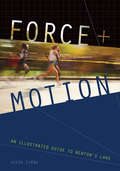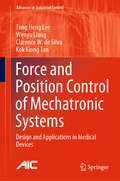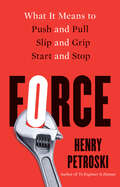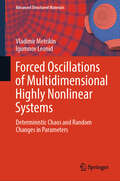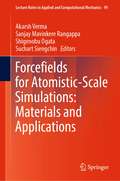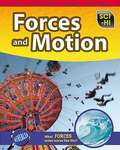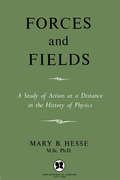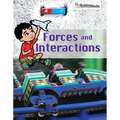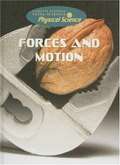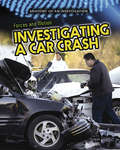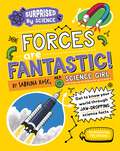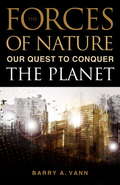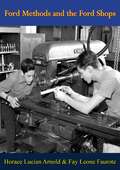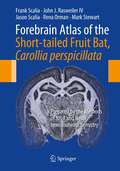- Table View
- List View
Force and Motion Resources: Images,Data and Readings
by FOSS Middle School Staff AssociatesScience Textbook
Force and Motion: An Illustrated Guide to Newton's Laws
by Jason ZimbaIsaac Newton developed three laws of motion that govern the everyday world. These laws are usually presented in purely mathematical forms, but Jason Zimba breaks with tradition and treats them visually. This unique approach allows students to appreciate the conceptual underpinnings of each law before moving on to qualitative descriptions of motion and, finally, to the equations and their solutions.Zimba has organized the book into seventeen brief and well-sequenced lessons, which focus on simple, manageable topics and delve into areas that often cause students to stumble. Each lesson is followed by a set of original problems that have been student-tested and refined over twenty years. Zimba illustrates the laws with more than 350 diagrams, an innovative presentation that offers a fresh way to teach the fundamentals in introductory physics, mechanics, and kinematics courses.
Force and Position Control of Mechatronic Systems: Design and Applications in Medical Devices (Advances in Industrial Control)
by Tong Heng Lee Kok Kiong Tan Clarence W. de Silva Wenyu LiangForce and Position Control of Mechatronic Systems provides an overview of the general concepts and technologies in the area of force and position control. Novel ideas and innovations related to this area are presented and reported in detail, and examples of applications in medical technology are given.The book begins by introducing force sensing, and modelling of contacting objects. In then moves steadily through a variety of topics, including:• disturbance observer-based force estimation;• force-based supervisory control;• stabilization systems;• controller design; and• control of tube insertion procedures.This book will be of interest to researchers, engineers and students interested in force control, particularly those with a focus on medical applications of these ideas.Advances in Industrial Control reports and encourages the transfer of technology in control engineering. The rapid development of control technology has an impact on all areas of the control discipline. The series offers an opportunity for researchers to present an extended exposition of new work in all aspects of industrial control.
Force, Motion, and Energy
by Uri Haber-Schaim H. Graden Kirksey Reed Cutting Harold A. Pratt Robert D. StairForces <p><p> Pressure <p> Forces Acting in Different Directions <p> Distance, Time, and Speed <p> Waves <p> Heating and Cooling <p> Potential Energy and Kinetic Energy
Force, Motion, and Work: Module K
by Leonard Bernstein Martin Schachter Alan Winkler Stanley WofeScience textbook
Force: What It Means to Push and Pull, Slip and Grip, Start and Stop
by Henry PetroskiAn eminent engineer and historian tackles one of the most elemental aspects of life: how we experience and utilize physical force &“Another gem from a master of technology writing.&”—Kirkus Reviews Force explores how humans interact with the material world in the course of their everyday activities. This book for the general reader also considers the significance of force in shaping societies and cultures. Celebrated author Henry Petroski delves into the ongoing physical interaction between people and things that enables them to stay put or causes them to move. He explores the range of daily human experience whereby we feel the sensations of push and pull, resistance and assistance. The book is also about metaphorical force, which manifests itself as pressure and relief, achievement and defeat. Petroski draws from a variety of disciplines to make the case that force—represented especially by our sense of touch—is a unifying principle that pervades our lives. In the wake of a prolonged global pandemic that increasingly cautioned us about contact with the physical world, Petroski offers a new perspective on the importance of the sensation and power of touch.
Forced Oscillations of Multidimensional Highly Nonlinear Systems: Deterministic Chaos and Random Changes in Parameters (Advanced Structured Materials #222)
by Vladimir Metrikin Igumnov LeonidThis book highlights the presentation of methods for studying oscillations under external periodic influence and random changes in parameters in dynamic systems with nonlinearities that have discontinuities and kinks. The analysis of dynamic systems is based on effective approaches and algorithms of the method of point mappings of Poincaré surfaces, developed by the Nizhny Novgorod Scientific School of academician A.A. Andronov. Considerable attention is paid to the study of the general picture of the possible behavior of systems and their use in solving various applied problems. Using specific examples, it is found that this research approach allows not only to advance in the study of known nonlinear features but also to discover new effects and applications. The presentation is illustrated by numerous specific examples of oscillatory strongly nonlinear systems with discontinuous nonlinearities or piecewise-continuous nonlinearities. A separate chapter is devoted to the development and use of the point mapping method for random changes in the parameters of dynamic systems, as well as in dynamic systems subject to external seismic loads. The book is intended for scientists and engineers who are engaged in research and practice activities related to the theory of nonlinear oscillations and its applications, as well as graduate students and senior undergraduate students in relevant majors.
Forcefields for Atomistic-Scale Simulations: Materials and Applications (Lecture Notes in Applied and Computational Mechanics #99)
by Suchart Siengchin Sanjay Mavinkere Rangappa Akarsh Verma Shigenobu OgataThis book describes the forcefields/interatomic potentials that are used in the atomistic-scale and molecular dynamics simulations. It covers mechanisms, salient features, formulations, important aspects and case studies of various forcefields utilized for characterizing various materials (such as nuclear materials and nanomaterials) and applications. This book gives many help to students and researchers who are studying the forcefield potentials and introduces various applications of atomistic-scale simulations to professors who are researching molecular dynamics.
Forces And Motion
by Casey RandHow does friction help you ride a bicycle? How does a submarine keep from sinking? What is equilibrium? The visually stimulating 'Sci-Hi' books take learning science core curriculum to a whole new exciting level. Each title explores an area of life, physical, or earth science in a way that is both engaging and comprehensive.
Forces Make Things Move
by Kimberly Brubaker BradleyForces are at work all around you. They affect things as small as a toy car and as big as the earth! Forces make things move, but they also make things stop. Some forces are very strong, but other forces are so weak, you can't feel them at all. But what are forces, and how do they work? Read and find out!
Forces and Fields
by Mary B. HesseForces and Fields by Mary Hesse is a history of physics surrounding the question: How do bodies act on one another across space? Hesse illustrates this through various answers, discussing period of transition in fundamental physics in which new concepts and ideas have been introduced and made scientifically testable, and makes a certain philosophical interpretation of science from the beginning. Some topics include the logical status of theories, primitive analogies, mechanism in Greek science, the Greek inheritance, Corpuscular Philosophy, The Theory of Gravitation and The Theory of Relativity, as well as others. Mary B. Hesse (born 1924) is a contemporary English philosopher of science. She is now professor emerita of the philosophy of science at Cambridge University. Her publication Models and Analogies in Science is a widely cited and accessible introduction to the topic. Hesse argues, contra Duhem, that models and analogies are integral to understanding scientific practice in general and scientific advancement in particular, especially how the domain of a scientific theory is extended and how theories generate genuinely novel predictions. Examples of such models include the famous billiard ball model of the dynamical theory of gases and models of light based on analogies to sound and water waves. Hesse thinks that, in order help us understand a new system or phenomenon, we will often create an analogical model that compares this new system or phenomenon with a more familiar system or phenomenon. In her book, Hesse makes a distinction between three types of analogues in scientific models: positive analogies, negative analogies, and neutral analogies. Positive analogies are those features which are known or thought to be shared by both systems, negative analogies are those features which are known or thought to be present in one system but absent in the other, and neutral analogies are those features whose status as positive or negative analogies is uncertain at present. Neutral analogies are by far the most interesting of the three types of analogies, for they suggest ways to test the limits of our models, guiding the way for scientific advancement. In the late 19th century, for example, the idea that light-waves have a physical medium called the luminiferous ether would have been best thought of as a neutral analogy with water and sound waves. Eventually, due to a null result in the Michelson-Morley and Trouton-Noble experiments, as well as other similar experiments, this analogy came to be accepted as a negative analogy - we now accept that light has no physical medium, unlike sound and water waves. The discovery of this negative analogy led to further advancement, including the unification of electro-magnetic theory with optics, and the eventual creation of new and more informative models of light.
Forces and Interactions
by Janette SchusterNIMAC-sourced textbook <p><p> This unit helps students understand the physical science concepts at work in forces and interactions.
Forces and Motion
by Robert SneddenGareth Stevens Vital Science books are designed to help prepare students for NCLB science testing by reinforcing key concepts across the science curriculum. The eight volumes in Physical Science use clear language and a variety of photographs and diagrams to increase students' understanding of forces and motion; light, heat, electricity, magnetism and sound; and the properties of objects they encounter in their daily lives. Two volumes discuss the history of science and the role of science in society. This book introduces Newton's Laws of Motion, friction, pressure, and more.
Forces and Motion: Investigating a Car Crash (Anatomy of an Investigation)
by Ian GrahamAn unfamiliar noise stops shoppers in their tracks: cars and a truck are crashing into each other. Fortunately no-one is hurt seriously, but what has caused the accident? This book looks at the topics of forces and motion to explain about speed, acceleration, friction, and momentum. It shows how investigators can use their knowledge of science and technology to sift through the evidence to determine the cause of the crash.
Forces are Fantastic! (Surprised by Science #3)
by Sabrina Rose Science GirlBe surprised by the astonishing science of forces, with Sabrina Rose, AKA Science Girl, the internet's most inspiring curator of facts and observations of our wonderful world - making it easy for all readers to come to love science!Surprised by Science: Forces are Fantastic brings an attention-grabbing and accessible set of facts about forces and physics to life! Doing what she's famous for online, Sabrina Rose dives into the most surprising details of the world of forces to explore the science at work. From black holes to gravity in space; from magnets in navigation to friction in storms - this series is perfect for inquisitive children age 7 and up, and all fans of Science Girl.Surprised by Science is a series of books that takes the inspiring communication and research skills of Science Girl's hugely popular platform and distills it on the page, with funny and engaging illustrations by Pipi Sposito paired with photos of the real-life science in action. The series includes: Electricity is Epic!; Plants are Powerful!; Forces are Fantastic!; Sound is Sensational!; Animals are Awesome!; Human Bodies are Brilliant!
Forces in Motion Physical Science
by Martin E. LeeThe book reviews physics fundamentals on force and motion. You will learn that in physics there are simple movements and complex movements and in order to understand motion, you have to think about forces, acceleration, energy, work, and mass.
Forces of Nature
by Barry A. VannThis illuminating overview of human population shifts and their precarious relationship with climate change and geography brings a unique perspective to understanding our age-old natural desire to inhabit picturesque landscapes or to transform once-desolate areas into new gardens of growth, all the while confronted by the dangerous, often life-threatening natural events that test our endurance. The author takes us on a journey along the ancient migration routes of our earliest ancestors and examines why many chose to settle in natural utopias with ample water; lush, fertile lands; and a moderate climate, while others were forced to make the most of far less inviting surroundings. Today, populations still shift. Some people migrate for devoutly religious reasons--outgrowing their surroundings, they move to the next available area, seeking a better life and spreading their religion--potentially instigating social conflict. We also now migrate in order to fulfill our wants and needs. Instead of settling near sources of water as a means for growth and survival, we seek out waterfront areas for their appealing landscape, though these spaces are already teeming with people. In contrast, many others are willing to move to new areas, no matter how inhospitable the clime, to earn a living. While there is still no technology that can protect vulnerable groups against the threatening features of the natural world, this book offers suggestions for how we can better adapt to challenging environments.
Ford Methods and the Ford Shops
by Horace Lucian Arnold Fay Leone FauroteIn "Ford Methods and the Ford Shops," Horace Lucian Arnold and Fay Leone Faurote provide a comprehensive and detailed exploration of the innovative production techniques and organizational practices that revolutionized the automotive industry. This seminal work offers an in-depth look at the methods that made the Ford Motor Company an industrial powerhouse and a symbol of modern manufacturing efficiency.The book meticulously documents the pioneering assembly line techniques introduced by Henry Ford, which dramatically increased productivity and lowered costs. Arnold and Faurote delve into the various aspects of Ford’s production system, from the design of specialized machinery and tools to the layout and operation of the assembly line itself.Key themes include:The Assembly Line: The authors provide a detailed analysis of the assembly line process, explaining how it transformed manufacturing by breaking down complex tasks into simple, repetitive actions. This innovation not only sped up production but also made it possible to produce affordable automobiles for the masses.Standardization and Efficiency: Arnold and Faurote explore the importance of standardization in Ford’s production methods. They discuss how interchangeable parts and standardized processes contributed to efficiency and quality control.Workforce Management: The book examines Ford’s approach to workforce management, including the introduction of higher wages and shorter working hours. These practices not only improved worker satisfaction but also increased productivity and reduced turnover.Business Philosophy: "Ford Methods and the Ford Shops" also delves into Henry Ford’s broader business philosophy, emphasizing his belief in making products affordable and accessible while maintaining high standards of quality and efficiency.This detailed and insightful book is a valuable resource for students of industrial engineering, business professionals, and anyone interested in the history of manufacturing. Arnold and Faurote’s comprehensive account of Ford’s methods provides a fascinating look at the principles and practices that reshaped the industrial landscape and set new standards for efficiency and innovation.
Forebrain Atlas of the Short-tailed Fruit Bat, Carollia perspicillata
by Mark Stewart Jason Scalia Frank Scalia Rena Orman John J Rasweiler IVThe Forebrain Atlas of the Short-tailed Fruit Bat, Carollia perpicillata, is unique among brain atlases. Not only is this the first quality atlas treatment of a bat species, but the atlas is also unique in its use of NeuN staining. Carollia perpicillata, a tropical species, is the only bat that has essentially been domesticated and can be maintained and propagated in a research environment utilizing simple, inexpensive husbandry procedures. The NeuN preparations used in this atlas selectively stain neurons in a sharp black coloration that fills not only the cell body but extends a short distance along the proximal dendrites. Thus, as distinct from the traditional nissl stains, which generate a shade of blue largely restricted to the cell body, the NeuN generates a quasi Golgi-like image of the neurons. This provides a more intimate view of the neurons than can be obtained from nissl staining. In addition, the background is essentially white, facilitating high-contrast photography and allowing for gray-tone illustration without any loss of information. The NeuN procedure does not stain axons, and since it does not stain glial cells or their nuclei, the noise ordinarily generated in nissl stains by the presence of glial cells among the neurons and in the white matter is entirely eliminated. The Forebrain Atlas of the Short-tailed Fruit Bat also includes nissl stained sections for two reasons: One, since some readers may be unfamiliar with the NeuN images, it is useful to include familiar images for comparison. More importantly, it is known that NeuN is not expressed in certain neurons, such as Purkinje cells, olfactory bulb mitral cells, and the cells of the paraventricular and supraoptic nuclei. The nissl stained sections are thus included to provide complementary views of such structures. The atlas will be useful for students and investigators doing neuroscience research on bat and other mammalian species, as well as students of comparative biology, zoology, brain evolution, and the history of neuroanatomical analysis.

